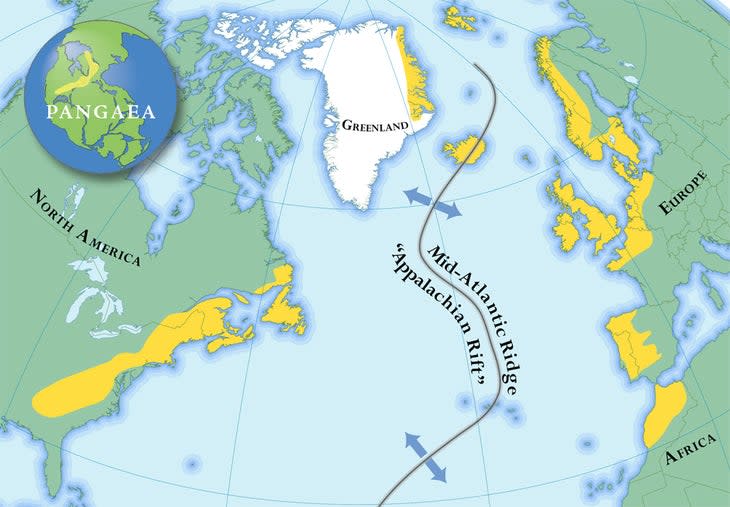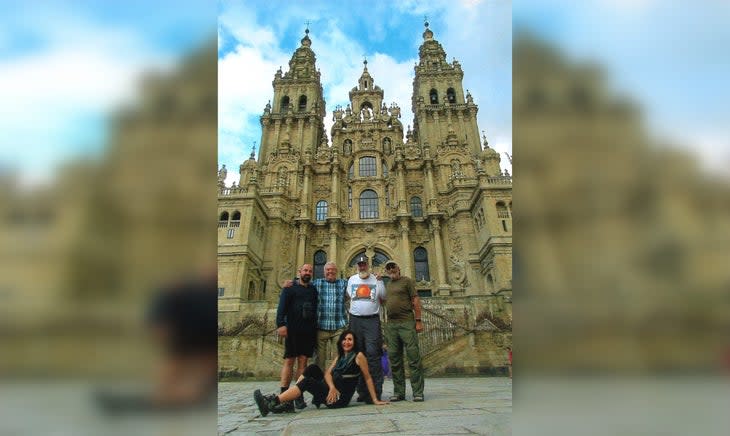Inside 75-Year-Old Will French’s Globe-Trotting Adventure on the International Appalachian Trail
This article originally appeared on Outside
Will French didn't know he was on the International Appalachian Trail when he began hiking it.
It was the spring of 2009, 11 years after French had sold his business and decided to hike the Appalachian Trail. That AT trip gave him the "disease", as he calls his addiction to thru-hiking. Nothing made him feel quite like hiking did: In the decade following his AT journey, French ventured to the Long Trail, the Colorado Trail, and the John Muir Trail.
Now, his love affair with long walks had taken him across the pond, where he and Tom Wheeler, a new hiking partner, tackled the Cape Wrath Trail, a 200-mile stretch of unmarked and underdeveloped track through the gorse-draped hills of Scotland. He decided to hike the trail largely on a whim, having responded to Tom's request for a partner in the back of a hiking magazine. It wasn't until later that fall, at the opening of the Appalachian Trail Museum, that French learned that Scotland was to become part of the International Appalachian Trail (IAT).
As challenging as thru-hiking is in practice, it's a simple concept at heart: Pick a long trail and keep walking until you've finished all of it. This may consist of an end-to-end footpath, a flip-flop, or even sections pieced together over years. Regardless, it all takes place on one stretch of dirt.
The International Appalachian Trail turns this simple notion on its head. Across the U.S. and 22 more countries and territories in North America, Europe, and Africa, the trail imagines what a thru-hike might have looked like 250 million years ago. It traces the path of the ancient Appalachian-Caledonian Mountains across the Atlantic Ocean, recalling an era before the continents split apart. Instead of a traditional end-to-end trip, a hike of the IAT is an ocean-hopping, world-spanning journey where backpackers have to decide their own rules. There's no set mileage or singular track, and unlike traditional thru-hikes, it leaves ample interpretation up to the hiker. It was, French realized, just what he was looking for.
"It's not a thru-hike, it's a hopscotch around," French says. "It was a moving target, but that's alright. It made it interesting."
When he first set out on the AT, French wasn't a stereotypical twenty-something dirtbag. At 50 years old, he had spent the decades prior working in technical education, teaching automotive workers to stay current with rapidly advancing technology. In his down time, he made trips from his lifelong home of Sterling, Massachusetts to dayhike and overnight in the formidable White Mountains.
"The White Mountains were a great place to learn," French says. "They're tough. I don't think I've hiked anything in my 10,000 miles that was tougher than the Whites."
On March 21, 1998, French stood surrounded by rime ice on Springer Mountain, Georgia, ready to begin his first long-distance trail. In the 197 days that followed, he found his "happy place," as his family calls it. The camaraderie of the trail made it feel like home.
"I was pleasantly surprised by the sense of community that existed," French says.
It was on that initial journey that French first learned of the IAT from fellow thru-hikers, who passed along the hype about a man named "Nimblewill Nomad." Nimblewill--real name M.J. Eberhart--had just become the second person to hike the Eastern Continental Trail from Key West, Florida to Cap Gaspe, Quebec. (He hasn't stopped in the 25 years since: In 2021, at age 83, he became the oldest known person to complete a thru-hike of the AT.)
"He gave me the awareness that someone's doing this thing," French says.
French seriously considered doing the IAT, which at that time was only an extension of the trail through northern Maine and Canada. He decided against it--too much road walking. Still, the trail sat in the back of his mind as he completed more and more domestic hikes, making friends along the way. He was always seeking out new adventures, which is what brought him to Scotland in the first place.
With his new friend Tom and two cousins in tow, French took a road trip up to Canada to hike in Newfoundland and Labrador, officially kicking off his quest to complete the IAT.
"That's maybe where the idea of 'what more can we do' came to mind," French says. "Eventually it became pretty much an annual thing as I had my sights on what the completion of this might represent."
The IAT begins where the AT ends for most, on the summit of Mt. Katahdin in Maine. From Katahdin, the trail heads north across the border into Quebec and the Maritime Provinces of Canada. It island-hops across the Atlantic via Newfoundland, Greenland, Iceland, the Faroe Islands, and the British Isles before reaching its second continental landmass. An ocean away, its European journey takes it from Norway and Sweden into Denmark, the Netherlands, France, Spain, and Portugal before reaching the Mediterranean, at which point it continues to its third and final continent, finishing up in Morocco. In each country, hikers can traverse historic trails designated by the IAT or create their own itinerary.

Once French decided on his goal--hiking in every country the IAT passes through to complete 2,160 total miles, the same distance as the AT--he created some guidelines that would make the overseas segments feasible and enjoyable for him. He would access trails via public transportation, rather than rental cars, and minimize road walking. French also decided to largely forego tent camping in favor of more solid housing, whether hostels or huts, whenever possible. By 2009, after all, he was 61. Over the years, he had ditched the eight-pound backpack from his AT hike, lowering his pack weight from 50 pounds to closer to 20.
As the years rolled by, French ticked off new sections of trail. In 2014, he hiked in Belgium, not an official IAT chapter but a part of the Appalachian-Caledonian geology. That same year, he completed a thru-hike within a thru-hike, the Camino de Santiago in Spain. Along the way, he joined up with a group of three other hikers from around the world, who dubbed themselves "the Four Amigos."
In 2015, French went with family to Ireland, hiking with his two young grandkids, including his resilient granddaughter, Poppy.
"She went every step without complaining. I think she might've been three, maybe four years old," French says. "They experienced it rather young, before they know it's appropriate to complain about these things." Afterward, he returned to North America, heading up to New Brunswick and Quebec to continue his Canadian IAT journey. This back and forth across the Atlantic became routine in the years to come.
"I got to the point where I was doing two a year: One overseas, and one, whether it was Canada or Maine, that I could drive to," French says. "So I'm starting to stack 'em up now, I see the light."
French completed the British Isles in 2016, hiking through the three kingdoms. He followed historic routes, including the Hadrian's Wall Path in England and the West Highland Way in Scotland. On that trip, he had one of his more memorable on-trail encounters. He was walking on the sidewalk in Edinburgh with his two grandsons when they encountered a small commotion.
"I said, 'What's happening?' and the next thing you know a Bentley automobile pulls up right in front of us and the Queen of England is sitting in the car," French says. "So that was an interesting trail magic."
Back in Canada that same year, French checked off Nova Scotia and Prince Edward Island before heading over to France in 2017, where he took in the history while walking the beaches of Normandy. Over the course of a month, he also traveled and hiked in the Netherlands and Denmark.
French says that Morocco was his most unique experience, and the only one he did with an organized group. He traveled with the Appalachian Mountain Club, hiking with local guides in the Atlas Mountains as they ran into nomads and their herds and explored the marketplaces of Marrakesh.
He ticked Sweden and Norway off the list, then completed his final pre-pandemic trip to Portugal in 2019 as a five year reunion with the Four Amigos, his tramily from the Camino de Santiago. His companions traveled from as far away as Australia to hike together again, a testament to the bonds formed on long-distance hikes.
After a two-year break for the Covid-19 pandemic, French got back to the IAT, heading north to Iceland and Greenland with longtime friend and hiking partner Tim Anderson, trail name LDM, short for Long Distance Man.
"We got volcanic smoke coming out of the snow," French says. "In Iceland, I get up in the middle of the night to pee, and the friggin' northern lights are staring at me."
Now 75, French was determined to finish his final two sections in 2023: The Isle of Man and the Faroe Islands. With his granddaughter Poppy, now 11, and grandson Morgan, 17, he hiked the 100-mile perimeter of the Isle of Man. At one point, while perilously close to a seaside cliff, French stumbled and fell into a thicket of thorns. His grandchildren, understandably worried, asked what they could do to help.
"'Take a picture, quick!' That was my reaction to it," French says.

This incident on his final trip is a perfect summation of the attitude that allowed French to complete 2,160 miles across 23 countries and territories: "Just go with it, roll with it, make do."
"You take the good with the bad," French says. "You do your best to be prepared, throw some common sense into the whole formula, and you can get by pretty well."
In the Faroe Islands, French did some research and found the highest point in the archipelago, 2,890-foot Slaettaratindur, and climbed to the top. On the summit, he marked the completion of a 14-year journey that had taken him--literally--halfway around the world.
"This high point in the Faroe Islands became the Katahdin of the IAT," French says. Even today, it all comes back to that original journey: The decision to hike the AT at 50 changed the course of French's life and everything he's done since.
French recalls a moment from that first thru-hike, when he stopped in Harper's Ferry, a milestone marking roughly the halfway point of the AT. He ran into a reporter for the Associated Press at the post office. She asked him for a piece of trail wisdom.
"I said, 'Everyone should run away from home when they're 50 and do something neat,'" French says. "I guess now I could update it to, 'Everyone should run away from home when they're 75 and do something neat.'"
For exclusive access to all of our fitness, gear, adventure, and travel stories, plus discounts on trips, events, and gear, sign up for Outside+ today.

